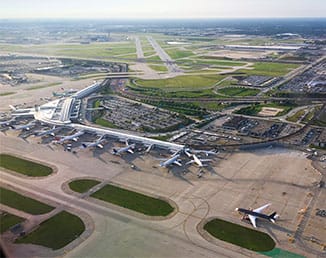Cirium recently hosted its inaugural Middle East Market Briefing, bringing together industry leaders and experts to analyze the region’s aviation landscape. The event provided a comprehensive overview of the market, covering everything from post-pandemic recovery and fleet growth to future forecasts and operational performance.
The briefing included presentations featuring global and Middle East insights, as well as a keynote interview with Firoz Tarapore, CEO of DAE Capital. It offered a detailed examination of current trends and future projections, highlighting the region’s robust growth and strategic importance in global aviation. This article recaps the key data and insights shared during the event.

Global economic context and market status
Stephen Burnside, Global Head of Cirium Ascend Consultancy began the briefing by setting the global macroeconomic scene. The current economic climate is diverging from the “goldilocks” scenario once envisioned for 2025-2026, where conditions were expected to be “not too hot, and not too cold.” Instead, many economic figures are approaching multi-decade highs or lows, creating a more complex environment for the aviation industry to navigate.
Despite these global headwinds, the airline industry is showing resilience. The International Air Transport Association (IATA) forecasts continued growth in airline revenue and profit into 2025, signaling sustained recovery and operational strength across the sector.
Middle East: a story of resilient recovery
A central theme of the briefing was the remarkable recovery of air travel in the Middle East. Andrew Doyle, Senior Director Market Development, provided an analysis of Cirium Diio FM traffic data which reveals that passenger numbers at Middle Eastern airports have not only bounced back from the pandemic dip but have surpassed pre-pandemic levels, reaching a new record in 2024.
This trend is also reflected in flight schedules. Data from Cirium Diio SRS Analyzer shows a consistent and strong recovery in scheduled passenger flights. This upward trajectory demonstrates the resilience of the region’s carriers and the sustained demand for air travel to, from, and within the Middle East. The area continues to solidify its position as a critical global hub.
Fleet dynamics: growth and future outlook
The in-service commercial fleet in the Middle East has experienced significant growth over the past three decades. Cirium Ascend Fleets Analyzer data illustrates a steady expansion across all market classes, from narrowbodies to widebodies. This growth trajectory is set to continue.
Aircraft orders and backlogs
The demand for new aircraft remains strong. The global single-aisle backlog is rising again, now equivalent to nine years of production at forecasted delivery rates. Similarly, the twin-aisle backlog has increased substantially in 2025, representing eight years of production. This indicates a long-term commitment from airlines, including those in the Middle East, to modernize and expand their fleets.
Aircraft values and lease rates
The strong demand for aircraft has also influenced market values and lease rates. Over the past year, values for all aircraft classes have increased by 4-16%. Widebody aircraft saw the most significant gains in lease rates, with a 14% increase year-on-year as of October 2024. This reflects the high demand for long-haul travel and the strategic value of widebody fleets for the region’s network carriers.

20-Year Fleet Forecast: doubling down on growth
Looking ahead, the Cirium 20-Year Fleet Forecast projects a bright future for the region. The global passenger fleet is expected to grow by 23,000 units over the next two decades, and the Middle East is a key driver of this expansion.
Middle Eastern carriers are forecast to grow at an impressive 4.9% annually. This growth will be propelled by the continued strength of Gulf network hubs and the rapidly expanding Saudi Arabian market. As a result, the region’s passenger aircraft fleet is projected to more than double by 2044, cementing its role as a powerhouse in global aviation.
Find out more about the 2025-2044 Cirium Fleet Forecast
Operational excellence and performance
The briefing also explored the operational side of the industry, highlighting the performance of Middle Eastern airlines and airports.
On-Time Performance
Many Middle Eastern carriers demonstrated exceptional reliability. The region’s airlines that achieved the highest rates of on-time departures during the first three quarters of 2025 were highlighted. Several carriers also showed significant improvement in their departure punctuality compared to the previous year, underscoring a commitment to operational efficiency and passenger satisfaction.
Ground events and maintenance
The region is also a key center for aircraft maintenance. An analysis of Cirium Ascend Ground Events showed that 14 heavy checks on Boeing 787 aircraft have been completed in the Middle East to date. This capability is vital for maintaining modern, complex fleets and ensuring aircraft are available to meet passenger demand.
Strengthening demand and fares
Data for Arab Air Carriers’ Organization (AACO) members shows that passenger demand has continued to strengthen throughout the year. This sustained demand underpins the positive financial and operational trends seen across the region.
A focus on sustainability
Sustainability was another important topic. A review of flight emissions revealed the Middle Eastern airlines and airports with the lowest emissions intensities for the period of January to September 2025. This highlighted the positive impact of operating modern, fuel-efficient fleets and showcased the region’s progress in addressing aviation’s environmental responsibilities.
Your partner in aviation analytics
The inaugural Middle East Market Briefing underscored the region’s dynamic and resilient aviation sector. With record passenger numbers, significant fleet expansion, and strong operational performance, the Middle East is poised for continued growth and leadership in the global industry.
Cirium’s data and analytics provide the foundation for understanding these complex market dynamics. If you would like to explore these insights further, our dedicated team in the Middle East is ready to assist.
Contact us to learn how Cirium can support your organization’s strategic goals.

























































